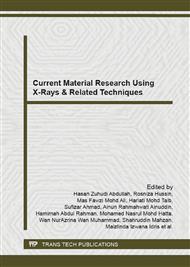[1]
L. Feng and J. Xu, "The role of plastic anisotropy deformation in fretting wear predictions," Wear, 260 (2006) 1274–1284.
DOI: 10.1016/j.wear.2005.08.003
Google Scholar
[2]
I. I. Argatov, "Asymptotic modeling of reciprocating sliding wear with application to local interwire contact," Wear, 271(2011)1147–1155.
DOI: 10.1016/j.wear.2011.05.028
Google Scholar
[3]
G. X. Chen and Z. R. Zhou, "Study on transition between fretting and reciprocating sliding wear," Wear, 250 (2001) 665–672.
DOI: 10.1016/s0043-1648(01)00675-5
Google Scholar
[4]
S. Fouvry, P. Kapsa, and L. Vincent, "Analysis of sliding behaviour for fretting loadings: determination of transition criteria," Wear, 185, (1995) 35–46.
DOI: 10.1016/0043-1648(94)06582-9
Google Scholar
[5]
M. C. M. Farias, R. M. Souza, a. Sinatora, and D. K. Tanaka, "The influence of applied load, sliding velocity and martensitic transformation on the unlubricated sliding wear of austenitic stainless steels," Wear, 263 (2007) 773–781.
DOI: 10.1016/j.wear.2006.12.017
Google Scholar
[6]
M. O. Alam and a. S. M. a. Haseeb, "Response of Ti–6Al–4V and Ti–24Al–11Nb alloys to dry sliding wear against hardened steel," Tribol. Int., 35 (2002) 357–362.
DOI: 10.1016/s0301-679x(02)00015-4
Google Scholar
[7]
A. Kapoor, "Wear by plastic ratchetting," Wear, 212 (1997) 119–130.
DOI: 10.1016/s0043-1648(97)00083-5
Google Scholar
[8]
N. Chelliah and S. V. Kailas, "Synergy between tribo-oxidation and strain rate response on governing the dry sliding wear behavior of titanium," Wear, 266 (2009) 704–712.
DOI: 10.1016/j.wear.2008.08.011
Google Scholar
[9]
G. List, G. Sutter, and J. J. Arnoux, "Analysis of the high speed sliding interaction between titanium alloy and tantalum," Wear, 301 (2013) 663–670.
DOI: 10.1016/j.wear.2012.11.070
Google Scholar
[10]
A. Kapoor and F. J. Franklin, "Tribological layers and the wear of ductile materials," Wear, 245 (2000) 204–215.
DOI: 10.1016/s0043-1648(00)00480-4
Google Scholar
[11]
S. Fouvry, T. Liskiewicz, P. Kapsa, S. Hannel, and E. Sauger, "An energy description of wear mechanisms and its applications to oscillating sliding contacts," Wear, 255 (2003) 287–298.
DOI: 10.1016/s0043-1648(03)00117-0
Google Scholar
[12]
G. K. Sfantos and M. H. Aliabadi, "Wear simulation using an incremental sliding Boundary Element Method," Wear, 260 (2006) 1119–1128.
DOI: 10.1016/j.wear.2005.07.020
Google Scholar
[13]
A. L. M. Tobi, J. Ding, G. Bandak, S. B. Leen, and P. H. Shipway, "A study on the interaction between fretting wear and cyclic plasticity for Ti – 6Al – 4V," Wear, 267 (2009) 270–282.
DOI: 10.1016/j.wear.2008.12.039
Google Scholar
[14]
E. O. Ezugwu and Z. M. Wang, "Materials Titanium alloys and their machinability," Journal of Materials Processing Technology, 68 (1997) 262–274
DOI: 10.1016/s0924-0136(96)00030-1
Google Scholar
[15]
E.J. Herselman. "An investigation of sliding wear of Ti6Al4V, University of Stellenbosch".
Google Scholar
[16]
K. Maekawa, "Temperature and wear of cutting tools in high-speed machining of Incone1718 and Ti-6A1-6V-2Sn," Wear, 202 (1997)142–148.
DOI: 10.1016/s0043-1648(96)07255-9
Google Scholar
[17]
G. Cassar, J. C. A.-B. Wilson, S. Banfield, J. Housden, a. Matthews, and a. Leyland, "A study of the reciprocating-sliding wear performance of plasma surface treated titanium alloy," Wear, 269 (2010) 60–70.
DOI: 10.1016/j.wear.2010.03.008
Google Scholar
[18]
N. M. Everitt, J. Ding, G. Bandak, P. H. Shipway, S. B. Leen, and E. J. Williams, "Characterisation of fretting-induced wear debris for Ti-6Al-4 V," Wear, 267 (2009) 283–291.
DOI: 10.1016/j.wear.2008.12.032
Google Scholar


